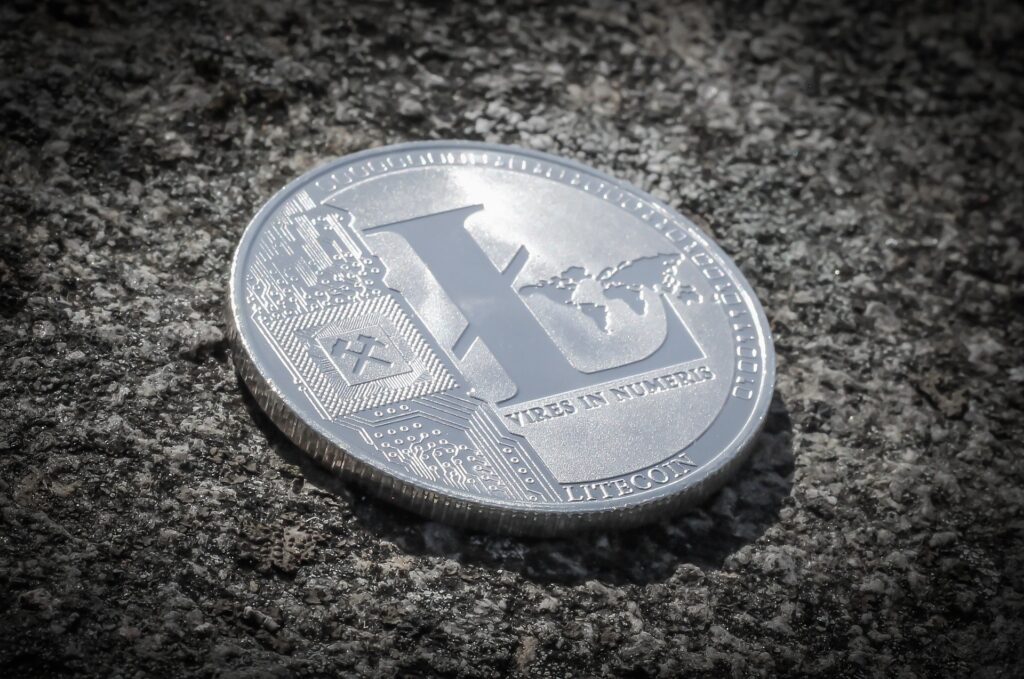Litecoin is a peer-to-peer cryptocurrency that was created in 2011 by Charlie Lee, a former Google engineer. It is a decentralized digital currency that operates on an open-source network, similar to Bitcoin. Litecoin is often referred to as the “silver to Bitcoin’s gold,” as it shares many similarities with Bitcoin but is designed to be more accessible and faster to transact with.
Like Bitcoin, Litecoin uses a blockchain to record transactions, but it uses a different mining algorithm called Scrypt. This algorithm is designed to be more memory-intensive than Bitcoin’s SHA-256 algorithm, which makes it more difficult for ASIC miners to mine Litecoin. As a result, Litecoin can be mined with consumer-grade hardware, which helps to decentralize the network.
Litecoin also has faster block times than Bitcoin, with new blocks being generated every 2.5 minutes compared to Bitcoin’s 10 minutes. This means that transactions can be confirmed more quickly on the Litecoin network.
Overall, Litecoin aims to provide a faster, more accessible, and more efficient alternative to Bitcoin, while still retaining many of the same principles and features.

Why was Litecoin created
Litecoin was created in 2011 by Charlie Lee, a former Google engineer, with the aim of creating a faster and more accessible alternative to Bitcoin. At the time, Bitcoin was already gaining popularity as a decentralized digital currency, but it had some limitations in terms of transaction speed and scalability.
Charlie Lee recognized that these limitations could be addressed by creating a cryptocurrency that used a different mining algorithm and had faster block times. So he designed Litecoin to be a more efficient and accessible digital currency that could complement Bitcoin.
In addition, Charlie Lee saw Litecoin as a way to experiment with new ideas and features that could eventually be implemented in Bitcoin. By creating a separate cryptocurrency, he could test these ideas without risking the stability of the Bitcoin network.
Overall, Litecoin was created to address some of the limitations of Bitcoin and provide a faster and more accessible alternative, while also serving as a testing ground for new ideas in the world of cryptocurrencies.
How is litecoin regulated?
Litecoin, like most cryptocurrencies, is a decentralized and global currency that is not regulated by any central authority or government. Transactions on the Litecoin network are verified by a network of nodes and miners around the world, and the integrity of the network is maintained by a consensus mechanism based on cryptographic algorithms.
While there is no centralized regulatory body governing Litecoin, it is subject to the laws and regulations of the countries in which it is used. In some countries, such as the United States, cryptocurrencies like Litecoin are regulated by financial regulatory agencies such as the Securities and Exchange Commission (SEC) and the Commodity Futures Trading Commission (CFTC).
In general, the regulatory approach to cryptocurrencies varies widely around the world, with some countries taking a more permissive approach and others implementing stricter regulations or even banning cryptocurrencies altogether. However, the decentralized nature of cryptocurrencies like Litecoin means that they are not subject to the same kind of centralized regulation as traditional financial instruments.
Is litecoin historically a good investment
As an AI language model, I cannot provide financial advice or opinions on specific investments, but I can provide some information on Litecoin’s historical performance.
Like most cryptocurrencies, Litecoin has experienced significant volatility and fluctuations in its price since its launch in 2011. There have been periods of rapid growth and price increases, as well as periods of decline and market corrections. In late 2017, Litecoin reached an all-time high of over $360 USD, before experiencing a significant decline in value during the 2018 cryptocurrency market crash.
It’s important to note that the cryptocurrency market is highly speculative and subject to a wide range of factors that can impact its value, including market sentiment, adoption rates, regulatory developments, and technological advancements. As such, investing in cryptocurrencies like Litecoin can be high risk and should be approached with caution.
If you are considering investing in Litecoin or any other cryptocurrency, it’s important to conduct your own research, evaluate your risk tolerance, and seek the advice of a financial professional.
where and how to buy litecoin
Litecoin can be bought and sold on a variety of cryptocurrency exchanges and trading platforms. Here are the general steps to buy Litecoin:
- Set up a cryptocurrency wallet: Before you can buy Litecoin, you’ll need to set up a digital wallet that supports Litecoin. There are many wallet options available, including desktop, mobile, and online wallets.
- Choose a cryptocurrency exchange: There are many exchanges that support Litecoin, including Coinbase, Binance, Kraken, and Bitfinex, among others. Research the exchange’s reputation, fees, and user experience before selecting one.
- Register and verify your account: Create an account on the exchange and follow the verification process, which usually involves providing personal identification information.
- Deposit funds: Most exchanges allow you to deposit funds using a bank transfer, credit card, or debit card. Some exchanges may also allow you to deposit other cryptocurrencies.
- Buy Litecoin: Once your account is funded, you can place an order to buy Litecoin on the exchange. Specify the amount you want to buy, review the transaction details, and confirm the purchase.
- Withdraw your Litecoin: After you’ve bought Litecoin, you can transfer it to your digital wallet for safekeeping.
It’s important to note that the process of buying Litecoin can vary depending on the exchange and the location of the user. Always research and follow the guidelines provided by the exchange to ensure a safe and successful transaction.
Here’s how to buy Litecoin on Binance:
- Sign up for a Binance account: Go to the Binance website (www.binance.com) and create an account. Follow the registration process, which will involve providing your email address and creating a password.
- Complete the verification process: To use all the features of Binance, you’ll need to complete the verification process. This involves providing personal identification information and may take a few days to be processed.
- Deposit funds: Once your account is verified, you can deposit funds into your Binance account. Click on the “Deposit” button next to the cryptocurrency you want to deposit (e.g., Bitcoin or Ethereum) and follow the instructions to transfer the funds.
- Navigate to the LTC/BTC or LTC/USDT trading pair: On the Binance homepage, click on the “Trade” button in the top menu and select “Classic” or “Advanced” view. Then, select the LTC/BTC or LTC/USDT trading pair, depending on whether you want to buy Litecoin with Bitcoin or Tether (USDT).
- Place a buy order: In the trading interface, specify the amount of Litecoin you want to buy and review the transaction details. You can choose to buy Litecoin at the current market price or place a limit order at a specific price. Click the “Buy” button to confirm the transaction.
- Withdraw your Litecoin: Once the transaction is complete, you can withdraw your Litecoin to your digital wallet for safekeeping.
It’s important to note that the process of buying Litecoin on Binance may vary depending on the user’s location and the exchange’s regulations. Always follow the guidelines provided by Binance to ensure a safe and successful transaction.
What are the best and safest litecoin wallets
There are many options for Litecoin wallets, each with their own unique features, security measures, and user experiences. Here are some of the best and safest Litecoin wallets:
- Ledger Nano S: The Ledger Nano S is a hardware wallet that supports multiple cryptocurrencies, including Litecoin. It offers strong security features, such as offline storage, PIN code protection, and a recovery phrase to restore your wallet in case of loss or theft.
- Trezor: The Trezor is another hardware wallet that supports Litecoin and other cryptocurrencies. It offers similar security features to the Ledger Nano S, including offline storage and PIN code protection.
- Exodus: Exodus is a desktop wallet that supports Litecoin and other cryptocurrencies. It offers a user-friendly interface and strong security features, such as two-factor authentication and local encryption of your private keys.
- Atomic Wallet: Atomic Wallet is a desktop and mobile wallet that supports Litecoin and other cryptocurrencies. It offers a simple interface, fast transactions, and a built-in exchange for trading cryptocurrencies.
- LiteVault: LiteVault is a web wallet that allows you to store and manage your Litecoin online. It offers strong encryption and two-factor authentication for added security.
It’s important to note that the best and safest Litecoin wallet for you will depend on your personal preferences, level of technical expertise, and security needs. Always do your own research and evaluate the security features and reputation of any wallet before using it to store your cryptocurrencies.
Can you mine litecoin?
Yes, Litecoin can be mined using a computer with specialized mining hardware and software. Litecoin uses a proof-of-work (PoW) consensus algorithm, similar to Bitcoin, which requires miners to compete to solve complex mathematical puzzles in order to validate transactions and earn newly minted Litecoin as a reward.
However, over time, the difficulty of mining Litecoin has increased significantly, and it is no longer profitable for most individual miners to mine Litecoin using their own hardware. Today, most Litecoin mining is done by large mining pools that combine their computing power to increase their chances of earning mining rewards.
If you’re interested in mining Litecoin, you’ll need to research the hardware and software requirements, as well as the costs and profitability of mining in your specific location. Keep in mind that mining can be energy-intensive and may require significant upfront investment in equipment and infrastructure. It’s important to consider all these factors before deciding whether to mine Litecoin or not.
Is Litecoin mining profitable?
The profitability of Litecoin mining depends on several factors, including the cost of electricity, the price of Litecoin, the efficiency of your mining hardware, and the current difficulty of mining.
In the early days of Litecoin, mining was relatively easy and profitable for individual miners using their own hardware. However, as the difficulty of mining has increased and the competition among miners has grown, it has become much harder for individual miners to earn a profit.
Today, most Litecoin mining is done by large mining pools that combine their computing power to increase their chances of earning mining rewards. These pools typically charge a fee for their services, which can eat into your profits.
If you’re considering mining Litecoin, it’s important to do your own research and calculate your expected costs and profits based on your specific situation. You should also keep in mind that the cryptocurrency market can be volatile, and the price of Litecoin can fluctuate rapidly, affecting your mining profitability.
Which celebrities endorse or have invested in Litecoin?
We are not aware of any celebrities who have publicly endorsed or invested in Litecoin. However, it’s important to note that investing in cryptocurrencies, including Litecoin, is a personal decision that should be based on one’s own research and financial situation, rather than celebrity endorsements or recommendations. Cryptocurrency investments are high-risk and speculative, and investors should be prepared to lose their entire investment.







